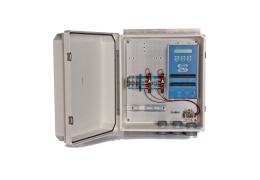The Biomet system is designed to record data from meteorological sensors that are often deployed in eddy covariance systems. At its core is a 9210B Datalogger, which is a precision data storage and communications device manufactured by the Sutron Corp. (Sterling, VA). It features expandable capabilities to accommodate numerous additional sensors and wireless communication devices.
Note: For instructions on using a Campbell® Scientific datalogger to collect Biomet data for use in a LI-COR eddy covariance system, see Using Campbell Scientific Dataloggers Installation Guide (available from LI-COR). LI-COR can also provide a generic CRBasic program (Biomet.dld) that accommodates all four standard biomet sensor packages available from LI-COR and can compile on a CR6, CR1000 or CR3000 datalogger.
The Biomet system is pre-configured with four optional programs, each of which supports a set of commonly-used sensors. These programs can be customized or you can create programs to support whichever sensors you intend to use. Using the Biomet system is a simple matter of assembling the hardware, connecting the sensors, and configuring the datalogger. Data are bundled with compressed .ghg files for processing in EddyPro software, processed in EddyPro as external biomet data, or retrieved and evaluated in a spreadsheet. These instructions provide basic assembly instructions for the enclosure and configuration instructions for the datalogger.
Important: Read all the instructions in this manual and become familiar with the 9210B User Manual (from the datalogger software CD) prior to deploying the Biomet sensor system. An improperly configured Biomet system may result in poor quality data or damage to equipment. Also become familiar with the manufacturer's documentation for each sensor in your system.
